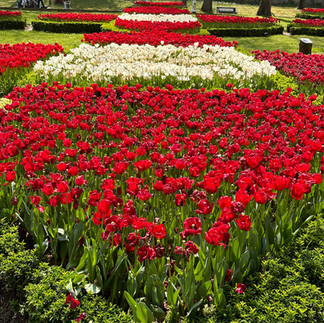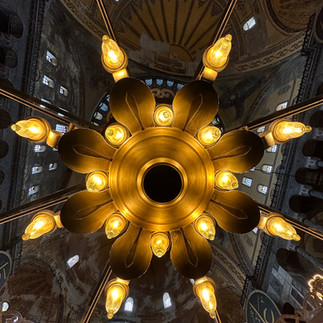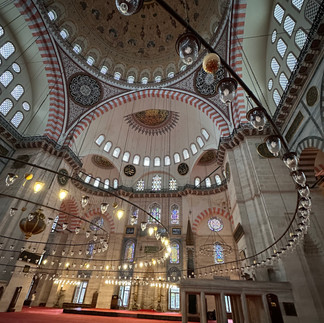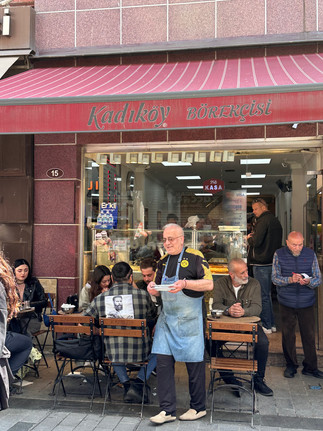Istanbul: Be calm - and carry some Turkish lira
- debbiemanderson1
- May 8, 2023
- 15 min read
Updated: May 28, 2023

Istanbul is the most unique and diverse city we have visited - the best reminder to us that when we travel, we are simply a visitor in someone else’s country.
With upwards of 16,000,000 people, Istanbul is the largest European city. As do most European cities, it has a long and chaotic history that is worth researching. It is situated in northwest Turkey and is unique in that it straddles two continents, Europe and Asia, divided by the Bosphorus Strait connecting the Black Sea and the Sea of Marmara and, eventually, the Aegean and Mediterranean Seas. It’s tucked up in the corner east of Greece and just Southeast of Bulgaria.
They say that Istanbul is a meeting place - of continents, of land and sea, of Byzantine (eastern Roman) and Islamic architecture, of cultures, and of past and present. Over 90% of the population is Muslim which has a large impact on the values and ways of the city. The rate of employment for women is less than half of that for men, so chances are high that you will notice way more men than women in any kind of retail or restaurant or service industry or simply out and about on the streets.
With this kind of setting, and with some 16 million visitors per year, you can imagine that Istanbul is an interesting city with many dynamics. The sights, sounds, smells, and energy will ignite all your senses. It’s understandable that this could make a visit a little daunting.
Let’s start with a few travel tips to make a visit go more smoothly.
First of all, you will need a Turkish Tourist Visa. It’s really simple to get - just go on line (only use the official Turkey tourism site to avoid being scammed), put in your information, pay about $60 US, and receive the visa in your email within seconds. Carry it with you and present it with your passport as you go through Turkish Immigration.
The Istanbul International Airport is one of the largest in the world but is easy to navigate. The immigration line is well-marked and quick. We have always been a proponent of having your hotel arrange a driver (for ease and safety purposes) and, in my opinion, it is a necessity in Istanbul. You will be given a three digit number of your driver’s company (ours was M44). Exit the Arrivals door and find the person with your number at the left of the door - he works as a liaison between the shuttle company and the driver, and he will escort you to the correct driver. It is all quite hectic around the Arrivals door, so be calm and just ask if you can’t find your liaison - people are very friendly and helpful in Istanbul. Take note that on your return trip, it might be wise to eat first because the food prices are the highest we have ever seen in an airport.
The Istanbul International Airport is ultra-modern, fancy, and expensive:
Then comes the drive from the airport into Istanbul. It takes about an hour - so be sure to factor this in for your return trip. The first part is fast-going, but as soon as you reach the main city, you will see traffic like you might never have seen before - Istanbul is the most congested city in the world. Traffic is everywhere, jammed up, jostling for space, touching bumpers, and honking horns. Don’t be “turned off“ by the apparent chaos; you will see that all of this chaos works, somehow, when you get settled in your hotel.
We researched hundreds of accommodations in Istanbul. For the first-time traveller, Old Istanbul, or Sultanahmet, is probably the best location. We chose a small, 14 room, hotel on a side street (I’ll give it a shout-out for location, cleanliness, and service: Muyan Suites) which was quiet and within walking distance to all the main sites. What some people dislike about a hotel - in this case, the side street or the noise of the calls to prayer - we appreciated about this small place of respite. Here’s our little hotel and my travelling companions having a final relax on the balcony with a view of the Bosphorus, below:

Money seems to be almost extinct in some parts of the world as credit cards take over, but Istanbul is one city where you do need to carry cash. As Canadians, we could not buy any Turkish Lira at home, so the best practice for safety and lower rates is always to use an ATM affiliated with your home bank, and try to use an ATM that is physically attached to the bank. Now, in Istanbul, with all the congestion making it impossible to attend physical bank buildings, there are rows of ATM’s from all the big and reputable banks that seemed well-managed and thus safe to use. At a minimum, you’ll need some cash for your daily Turkish Delight ‘fix’.
Istanbul is a walkable city, and that was our main mode of transportation. But if you walk, beware! The drivers are fast and aggressive. We did not see a stop sign anywhere. We joked that pedestrians and crosswalks are merely a suggestion for drivers to stop. If there is a walk signal, watch out - if the green walk sign starts blinking, you will have about two seconds, and then it is like the start of a NASCAR race with the cars roaring into the intersection, pedestrians or not. And the tram lines are about six inches (or so it seems) from the sidewalk. So watch that you don’t get bumped onto the street. And be alert for holes or bumps or obtrusions in the sidewalks - and the odd sleeping dog or cat. Having said all of this, we did not witness any accidents, proof that the system (usually) works.
Only one of the many possible obstructions on the streets and sidewalks of Old Istanbul:

And this is ‘reserved parking’ by our hotel, a stool and piles of bricks:

Istanbul has a metro/tram and bus line and also a ferry line that is simply considered part of their transportation loop. You obviously need a ticket to ride the metro or bus or ferry, and you can use the same type of ticket for any form of transportation. The Istanbulkart, a contactless card for payment which you can top up at payment machines, is definitely the cheapest way to go. Or you can buy a three-ticket pass. Regardless, it costs about $1.00 Canadian for a ride. So easy - once you have a ticket. Now, here’s a tip pertaining to the ticket machines. We wasted hours trying to acquire tickets. One of the issues is that you have to use cash. We did not find any ticket machines that used credit cards. (Well, we found one machine that said it accepted cards, but the card option did not work.) So, off to the ATM for cash. But then we learned that the ticket machines use only certain cash denominations, no larger than 50 Turkish lira. But the ATM machines usually dispense larger denominations unless you specifically withdraw 50 lira or less. So, back to the ATM. Once we figured all of that out, riding the transportation loop was easy. And the good news is that multiple people can use either the Istanbulkart or the three-ride pass. You just tap the card, walk through the turn style and hand it over to the next person in your party. The remaining total will show up on a little screen. This is an example of the need to be calm and get some Turkish lira - and in smaller denominations. Here’s a picture of my travel companion trying to acquire some transportation tickets and the treasure at the end of the hunt:
As a first time visitor, there are probably three or four main attractions or interests in Istanbul.
There are several (about five) huge palaces plus some mini-palaces (summer homes?) in Istanbul constructed for Ottoman Sultans. One of the main is right in Sultanahmet, steps from our hotel, the Topkapi Palace (or ’cannon gate palace’), but we chose not to attend due to the steep admission price. It does look beautiful in pictures, and it is part of the UNESCO World Heritage Sites. Topkapi was the first Ottoman palace in Istanbul. There is a beautiful garden, Gulhane, running alongside and on the grounds that is perfectly manicured with thousands of tulips and is a great place of respite and a lovely stroll.
Gulhane Park:
One of the largest palaces sits on the edge of the Bosphorus strait, Dolmabahce Palace. We saw it from the water. This palace was built in the 1800’s for Sultan Abdulmecid who thought Topkapi Place was deteriorating. He wanted a palace that would rival the most luxurious castles in Europe.

A good theme trip might involve checking out every palace in Istanbul. They were definitely the height of opulence and luxury.
As we all know, Istanbul is known for its mosques (or Camiis). In fact, there are over 3,000 mosques in Istanbul, ranging from picture postcard magnificent domed structures to wooden buildings on side streets. It’s impossible to see them all - unless, of course, you’d like to make it a theme for future trips to Istanbul - but that’s still A LOT of mosques to check out. There are several that are essential to visit, however, on your first visit, and they are all in close proximity: the Blue Mosque, Hagia Sofia, the New Mosque, and the Suleymaniye Mosque. All are magnificent structures that dot the skyline (and serve as good guiding landmarks for you when you become disoriented), all with their own style. The insides are one big empty room for prayer, again with their own spectacular design. The Blue Mosque and Hagia Sofia sit right along the Hippodrome, or Sultanahmet Square, a pleasant walking plaza formerly the site of chariot races dating back to the year 330. Mosques are free to visit but are closed for about half an hour after each call to prayer five times a day, so it’s helpful to find out the prayer times. Women need to have a head covering - a scarf or a hood. Everyone must remove their shoes before entering. Photography is allowed but not with flashes and none of people praying. Lineups can be astoundingly long. It is best to go early or later in the day and, if it is raining, that makes a visit even easier. Photos of the mosques at night are breath-taking and just like you see on postcards.
The Hippodrome, or Sultanahmet Square, flanked by the Blue Mosque and the Hagia Sofia Mosque:
The Blue Mosque:
Hagia Sofia Mosque:
The New Mosque:
The Suleymaniye Mosque:
Another major activity is to visit a market. Istanbul has over 200 markets, but you are probably familiar with the Grand Bazaar and the Spice Market from pictures and movies. This is another great rainy day experience, especially first thing in the morning when it is less crowded. These markets can be overwhelming. The Grand Bazaar has 61 covered streets (alleys?) with some 4,000 shops and up to 400,000 visitors a day. We highly recommend just strolling, looking at shop after shop of carpets, leather, glasswork, clothes, and trinkets, having a cup of traditional tea at a little cafe, and especially marvelling at the tea runners, men who carry up to 10 little glass cups of steaming hot tea on a platter in one hand to the different vendors. They literally run and never crash or spill their tea and never seem to get lost. The tea runners might not get lost, but I guarantee YOU will get lost - that’s part of the fun. And you will hear every possible sales pitch from men trying to lure you into their shops and sell you anything and everything. Just smile and say ‘No thanks’ and keep walking. We received so much enjoyment at the Grand Bazaar. The Spice Bazaar is slightly smaller and a mecca for spices, nuts, sweets, and teas. The colours and smells are amazing. It’s all a photographer’s dream.
Pictures from the Grand Bazaar (you can see that early morning on a rainy day is the perfect time to go):
The Spice Bazaar:
Also high on the visitor list is a cruise up the Bosphorus Strait between European and Asian Istanbul. There are men all along the waterfront who will be trying to sell you cruise packages but a good trick is to simply take the public transport ferry from the Eminonu terminal for the cheap price of about $4.50 per person. The trip goes to the end of the Bosphorus Strait, stops at the little fishing village of Anatolu Kavagi for about two and a half hours, and then returns for about an eight hour trip in total. We marvelled at the boat traffic on the Bosphorus, like a super highway for boats of all sizes. The scenery is beautiful, passing palaces and mosques and affluent mansions and stopping at several docks along the way. And, another tip - because it is a public ferry, the little cafe onboard is really affordable. We paid about $2.50 for two Americanos and a packet of 12 digestive biscuits. In Anatolu Kavagi, you will be accosted by man after man trying to entice you into their restaurant. Walk around and take your choice - but chances are that numerous restaurants are owned and managed by the same people. While at Anatolu Kavagi, you have the option of walking up to a castle before your return Bosphorus cruise. Do stop at the little bakery for some sweets.
Some shots of the Bosphorus cruise:
The little village of Anatolu Kavagi:
I’ll just pop in a word here about the Istanbul eye symbol, the Nazar Boncuk, that you will see everywhere - in trees, on the streets, in restaurants and hotels - as we bought one in Anatolu Kavagi. The eye is an amulet traditionally believed to absorb the jealousy and envy of others so those evil vibes don’t harm you. We could all benefit from that! (It’s probably more of a tourist interest these days.)

The Bosphorus Cruise is a good way to relax from the bustle of Sultanahmet. But there are a few other areas of Istanbul that are less chaotic.
One great way to spend the day is to walk across the Galata Bridge to Beyoglu and, on the way, watch the men fishing from the bridge. There are hundreds of them. Fishing is a huge pastime in Istanbul. The views towards ‘new Istanbul’ and down the Golden Horn are picturesque. The bridge is unique as the bottom level is lined with restaurants one after another - now, we did notice that the menus all looked pretty much identical, so we are wondering if one person owned all the supposedly different restaurants? A fun activity is to stop for a fish sandwich handed over from a boat right beside the bridge - again, take cash.
Fishing from the Galata Bridge:
Boats dispensing fish sandwiches by the Galata Bridge:

On the other side of the bridge, you will initially find it is a little hectic and maybe overwhelming but you can soon leave this behind. To the left are small streets lined with hundreds of hardware ’stores’ selling nails and bolts and anything else related to hardware which we found quite fascinating. The funicular or tram to the Galata Tower (a medieval watchtower), the most significant sight in Beyoğlu, is just to the left of the bridge - if you have some tickets - but we actually preferred walking up the winding streets that were much quieter and lined with cafes and shops. You can get a good view of the city from the top of the tower if you choose to pay and, probably, stand in line. We then strolled up the Istiklal Cadessi, the main pedestrian shopping and entertainment street leading up to Taksim Square, a busy dining, drinking, and shopping area. The streets heading off of Istiklal are much quieter and more pleasant and lined with quaint shops and cafes. This part of Istanbul seems much more modernized (it is known as ‘new town’ as it is only 2,000 years old) with some large stores, banks, businesses, schools, and restaurants. There is an affluent area along the Bosphorus Strait where cruise ships dock and where streets are lined with restaurants, high-end shops, and expensive hotels. There is a nice walk all along the harbour. We enjoyed, again, watching the men fishing and frying up fish on their little barbecues or making a pot of tea over an open fire or selling fish on a bun. It gave a whole new meaning to the term ‘small business‘ - such a contrast between the affluent area and the fellow selling fish off his portable barbecue.
Some of the more orderly hardware ‘stores’ by the bridge:


The steep walk up to the Galata Tower:
The Galata Tower:
Istiklal Cadessi is a long pedestrian street lined with modern stores and restaurants, but there is a popular tram that runs the length:

Istiklal is also known for the Church of St. Anthony (the largest Catholic Church in Istanbul) and the prestigious oldest high school in Istanbul (behind a locked gate):
We liked the side streets in Beyoglu:




Me, in a pensive mood in Beyoglu. I would have liked to spend more time wandering the quieter streets.

‘Small businesses’ along the Bosphorus:
A second more quiet area, and well worth a short 30 minute ferry ride winding through all the water traffic across the Bosphorus Strait, is a visit to Kadikoy, on the Asian side of Budapest, again catching the ferry from Eminonu terminal. They say to pick up a Simit (sesame bagel) beforehand and grab a coffee as soon as you get onboard, and enjoy the short ride. Kadikoy has a more western European atmosphere and is considered authentic citizen local life in community Istanbul. There is a huge market that covers street after street, lined with restaurants, cafes, and produce (the produce is known to be some of the best in Istanbul). One of our tastiest lunches, phyllo pastry filled with spinach, meat, and cheese, occurred in the market. As we hunted down the statue of Kede Tombili, a famous cat in Istanbul’s recent history, we walked down several commercial streets. We were intrigued by shop after shop, several floors deep, selling designer wedding dresses and, sure enough, we passed a large facility where several large weddings appeared to be in progress. Weddings must be popular in Istanbul. I will have to check out the well-known Kadakoy street art next time as there simply isn’t time in one trip to do everything.
Some random photos from Kadikoy:
On our last day, with a few hours to spare before we headed to the airport, we took the metro to the Aqueduct of Valens which dates to the year 368, strolled through a large market with precisely displayed vegetables where locals shop, admired the Sultan Monument, and then walked through the Fener and Balat areas along the Golden Horn, an inlet dividing old and new Istanbul. These areas are neighbourhoods with colourful houses and shops and cafes far away from the throngs of people in Sultanahmet. Many artisans live here. This, apparently, is prime real estate.
The Aqueduct of Valens, the street market in Fener, and the Sultan Monument:
Turkey has some great food traditions. This, of course, is the home of Turkish Delight - my favourite flavour was naturally-sweetened pomegranate with pistachios rolled in rose petals. Rose petals! We laughed that I had my own ‘dealer’ close to our hotel for my daily ‘fix’. Then there is the Baklava. My favourite was chocolate pistachio (my ‘dealer’ gave me a free piece). Grilled fish is on every menu. Kebabs are popular. Our most fun meal was a traditional Turkish Testi Kebab, or kebab in a clay pot set aflame at your table. ‘Doners’ (lamb or beef) are popular. ‘Borekcisi’ (stuffed phylo pastry) is amazing. We ate Turkish pancakes with dips while we sat on cushions on the floor. Fish sandwiches are everywhere. Pita bread is popular with several dips such as tsatsiki, eggplant, and red pepper. ‘Pide’ is similar to pita pizza. Bakeries take pride in their cake delicacies. Then there are the hundreds of carts selling roasted chestnuts, corn on the cob, and Simit (thin sesame-covered bagels). And our hotel served us Turkish coffee, thick and dark and strong. All are taste sensations.
Here’s the most fun meal, the Testi Kebab - flaming, tapping the top off, and the wonderful results, beef or chicken stew:
This is my partner learning how to drink Turkish coffee. You cleanse your mouth with water, sip the coffee, turn the empty cup over, let it sit for a few minutes, and read your fortune in the dregs in the cup. Get rid of the aftertaste with a piece of Turkish Delight.

Finally, a word about those cats. There are cats everywhere. You will see them on the sidewalk, in parks, in the middle of the street, sitting on a cafe chair or table, or walking into a mosque. Please read my previous blogpost or listen to my podcast about Kede Tombili and the importance of cats in Istanbul‘s history and Islam faith and why you can’t just ’shoosh‘ them away.
You might wonder, with all of those people, how safe is Istanbul, especially if you are female? We were happy to report that we all felt safe at all levels. Of course, normal precautions have to be taken in any tourist and public area - keep your belongings and wits about you. Watch that traffic! There is a large tourism police presence, especially in the main parks and squares where they monitor all the gates, entering and exiting. The major administrative buildings are all protected by armed police. As women, we were treated very well and with respect and never once felt threatened. Don’t drink the tap water (bottled water is available everywhere) and only eat street food from licensed vendors who have lots of customers. Leave the cat-petting to your family pet at home. And if you have severe nut or cat allergies, you might want to take precautions - nuts (especially pistachio, almonds, and walnuts) are as prevalent as cats in Istanbul. And all those fellows trying to entice you into their shops and restaurants are not at all aggressive.
Probably not built for speed but for manoeuvrability:

So, that was our adventure in Istanbul. Personally, I wished that we had a few extra days to explore the areas outside of Sultanahmet in more depth because there really seems to be two different worlds in Istanbul, the traditional and the modern colliding.
Yes, Istanbul is tiring and sometimes overwhelming, but as I said, “Our minds would never be the same if we hadn’t been to Istanbul”. You have to set your preconceived notions and biases aside and just lap up the diversity, differences, noises, smells, tastes, and chaos. It is truly a world apart.
With some planning, your trip can go smoothly. Just be calm, and take out some Turkish lira.










































































































































































































































Comments